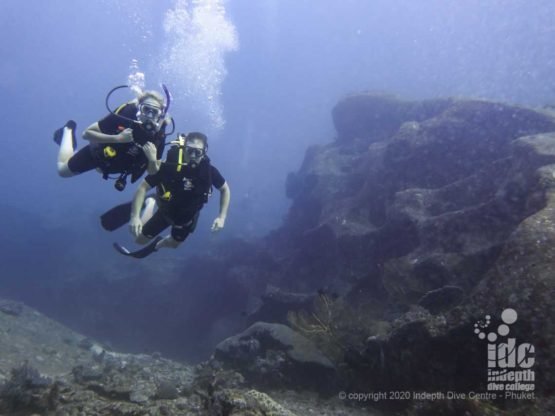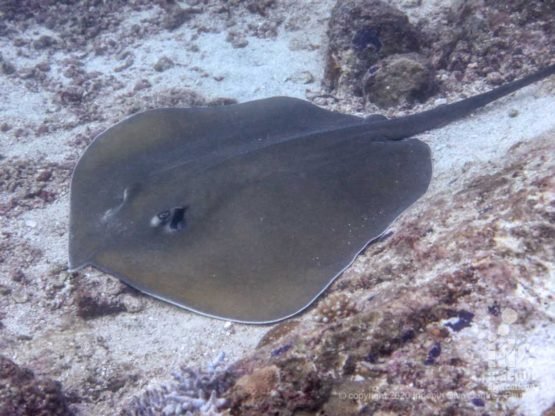
Similan Islands No 9: North Point or Rocky Point
North Point is located on the Northern tip of Island 9, hence the name. This dive site is located and is between Christmas Point and Breakfast Bend / Three Trees, and as such, North Point offers everything that those who visit the Similans want and expect. Typical of the Similans, North Point consists of a series of boulders lying parallel to the shore going progressively deeper. This in turn creates a series of canyons and “swim-throughs” all through the dive site where the boulders meet and rest on each other.
With its dramatic underwater scenery North Point is a firm favorite among divers and it is easy to see why. North Point has deep clear blue water often up to 40m+, tons of healthy life and an opportunity to see some large pelagic visitors. We have regular sightings of White Tip Reef Sharks, Stingrays and large Marble Groupers. Moreover you have Napoleon Wrasse, Barracuda and turtles as well as the usual marine life typical to the Similans. All of this makes this North point a firm favorite with our regular customers.
What more could you ask for?


Similan Island No. 9 (Koh Bangu) is home to several superb dive sites: North Point being one
To start your dive, you will find there are two mooring lines on the Similans dive site. However, we recommend that you use the Orange mooring line as a reference for descent as the yellow mooring line is very deep. The current can run in any direction on this site and would be described as moderate to strong.
The bottom of the mooring line is around 25m and if the current will allow, try and head North / North West around the rocks. As such you will find the top of the rocks is around 20m and the sandy bottom is in excess of 30m. In the sandy areas, you can expect to see Blue Spotted Rays and quite literally thousands of Garden Eels and Gobies. Additionally, there is a good chance of seeing a Bent Stick Pipefish out on the sand.
Deep Diving in The Similans
If you are new to “Deep Diving” then this is a great Similan dive site to do you Deep Adventure Dive. This is The Deep Dive from the PADI Advanced Open Water Course. You should do this because it will allow you to dive beyond 18m which is perfect for the Similan Islands. In fact, the Similan Dive Sites can generally split be into one of 2 categories: shallow dives of less than 10m, or deep dives deeper than 20m.
Having said that if the current is ZERO then you can make the swim across the sand to North Point Pinnacle. However, do NOT attempt this in strong current as you will not make it back to the main dive site!
The swim is around 80m from the main North Point dive site and you just head North West. Thus you want to be swimming in the mid-water and keeping an eye out below for Leopard Sharks and large Stingrays. When you reach the pinnacle the top of the rocks is between 25-35m. These are covered in huge Gorgonian Sea Fans as well as hard and soft corals. Remember to keep an eye out in the Sea Fans for Long Nosed Hawkfish. This pinnacle is a wealth of marine life and you can expect to see most things from the Similans here.
Be aware that the sandy bottom drops off to 50m+, so dive well within your training and experience. Additionally, be extra aware of your remaining dive time / No Decompression Limits. If you headed West around the rocks then head back south and if you swim in the mid water you will reach the main dive site after a few minutes.
Rebreather divers are as usual at an advantage here as the fact that the depth and current has little to no effect on their dive time or gas consumption!
Consequently, if you are diving on a rebreather take your time to explore here. Rebreather divers can easily do a 2-3 hour dive here so you will have lots of time to see most of this great dive site.
Once you are back at the main dive site there is a nice swim-through at 25m on the Northern edge of the large cluster of boulders. Therefore, if you continue South, in other words back towards Island No. 9, then there is a very large channel. Thus if you enter from the Western end, there is a ledge at the beginning of the channel at around 20m. When you find it, it is well worth spending some time here. If you look carefully among the Whip Corals, you can find Ornate Ghost Pipefish and Pygmy Pipe Horse. While the latter are very hard to spot, and not always there, they are very rewarding to find.
Again, Rebreather divers will ample time to look for these. And if you do find any, they make great photo subjects if you can find them.
If you then head East along the channel you will find Lionfish, Tiger Cowries and Nudibranchs. The channel then gets shallower to around 16 m and there is a large boulder at around 12m. Now go over the boulder and you will drop back down to a depth of around 14m. There are lots of hard and soft corals here and just to the North East is the mooring line where you started the dive. Hence it is not only good navigation practice but you can also see Red Fire Gobies around this area.
The Coral Finger Garden:
Once you are at the end of the channel, head South into the shallower water. Here there is an enormous field of Finger Coral (Porites furcata) here, quite literally larger than a football field. This, not surprisingly, is covered in Marine life and you can easily spend a long time here. Now head South-East for about 20m and there is another smaller channel at a depth of around 12m. This is another good place to spot Cowries and Nudibranchs. If you go down this smaller channel from West to East, you return to the large field of finger coral. This is full of Giant Morays, Angelfish, Butterfly Fish, Tuna and Trevally. In addition to the Anemone Fish, Box Fish, Trumpet Fish, Trigger Fish and Sea Snakes. This is a typical Similans Dive Site and we could list pages of what you are likely to see.
Moreover there are several Turtles on the dive site which are normally hanging around in the Finger Coral field. And there are also some Napoleon Wrasse which can be seen here and very occasionally you can see a Manta Ray. Mantas have been sighted in less than 10m over the Finger Coral field. Once you enter the large Finger Coral field just zigzag across it to cover the most you can. Sooner or later you should meet at least 1 turtle on your travels.
This field of Finger Coral goes up to a depth of less than 5m. As such when you are ending the dive, swim directly North into deeper water for an easy boat pick up.
We hope you enjoy this dive site as much as we have ...












